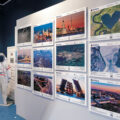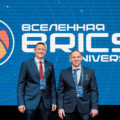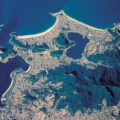- Снимки из космоса сделаны космонавтами С.В.Кудь-Сверчковым и И.В.Вагнером / Photos from space taken by astronauts Sergey Kud-Sverchkov and Ivan Vagner
- Рио-де-Жанеро, Бразилия / Rio de Janeiro, Brazil
On February 1, 2024, the BRICS Universe project, a series of photo exhibitions under the auspices of the Commission of the Russian Federation for UNESCO, was launched. The exhibitions feature photos of UNESCO Creative Cities in BRICS countries taken from the surface of the Earth and from space.
Open space
The BRICS Universe is a joint project of the Roscosmos State Corporation, Nizhny Novgorod Grechko Planetarium, and the Russia–BRICS Project Office for International Youth Cooperation. In August 2023, the project received a grant from the Presidential Foundation for Cultural Initiatives and was included in the Plan for the Russian 2024 BRICS Chairmanship.
The project’s idea came from Galina Muromtseva, Director of the Nizhny Novgorod Planetarium, and the concept was developed by the Creative Industries Foundation of the Ulyanovsk Region. The BRICS Universe is a cross-cultural project designed to connect space as an innovative field of human activity with the art of photography, whose artistic language needs no translation and is understood anywhere in the world. The project has a lot in common with the UNESCO Creative Cities program, which unites cities that strive to share their experience, ideas, and latest achievements to facilitate cultural, social, and economic development. Another goal of the project is to show how much Russia is doing for the humanitarian and technological development of mankind, including in the field of space exploration.
The Earth through the porthole and through the lens
To show the beauty and vibe of UNESCO Creative Cities, the project’s organizers invited 48 Russian and 41 international photographers from BRICS countries. 20 most striking images were selected from among 600 photographs. A special place in the collection was reserved for the photos taken by Russian astronauts Sergey Kud-Sverchkov and Ivan Vagner from the International Space Station. Photographing your home planet from space is not easy: to catch a spectacular shot, you need to patiently wait for the right moment. “There are a lot of beautiful places on Earth, and it’s hard to name them all: the Bahamas, African Highlands, Namib Desert, Victoria Desert in Australia, the glaciers and lakes of Patagonia, and so on. Our planet is rich in picturesque places that are all unique in their own way. The planet is changing all the time: the clouds, lighting, colors, and seasons constantly change. The Earth is never the same; it lives. At night, it is clearly visible where people live on the planet and where they do not. The light of cities breaks through even the densest clouds,” says Sergey Kud-Sverchkov. The astronaut emphasized that it is the combination of views from space and the surface of the Earth that fully reveals the beauty and diversity of our planet.
World without borders
The project was first launched at the Moscow Museum of Cosmonautics and then picked up by the Glushko Museum of Cosmonautics and Rocket Technology in St. Petersburg. In May, the photographs were exhibited in Rio de Janeiro (Brazil), Kargopol (Russia), and Beijing (China). The exhibition contributes to the development of common humanitarian space of BRICS countries and shows that people in different countries want to know more about each other and highly regard Russia’s achievements in the field of space exploration. For example, at the opening of the exhibition in Rio de Janeiro, the organizers asked the audience, “What was the name of the first artificial object to orbit the Earth?,” and they responded in unison, “Sputnik.”
By the end of the year, the exhibition will travel all over the world, with its route including Nizhny Novgorod (Russia), Ulyanovsk (Russia), Mumbai (India), Durban (South Africa), and Kazan (Russia). This means that thousands of people will be able to embrace the idea expressed by Ivan Vagner, “When you look at the Earth from space, you don’t see countries and borders. Borders were invented by people. The Earth is our common home even if we speak different languages.”
Maya Koshkina



